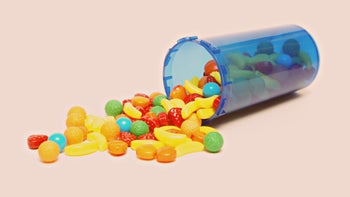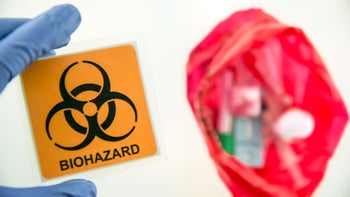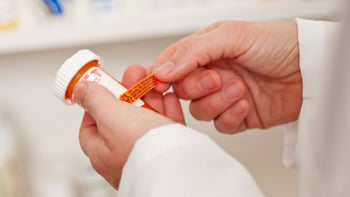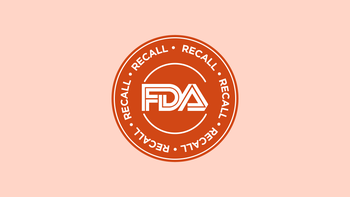
Why Drug Interactions Happen — Plus Common Interactions to Watch Out for
Key takeaways:
Drug interactions affect how a medication works and can sometimes cause unwanted side effects.The three types of interactions are drug-condition, drug-drug, and drug-food interactions.
Drug interactions are predictable and can often be limited or avoided. Digoxin (Lanoxin), warfarin (Coumadin, Jantoven), and levothyroxine (Synthroid) are examples of medications that have many interactions.
To best manage drug interactions, make sure to let your healthcare provider and pharmacist know all of the medications you’re taking, including over-the-counter medications and supplements.
Table of contents
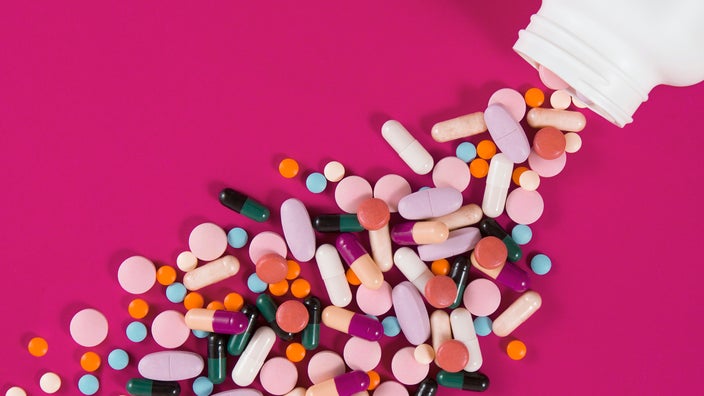
When you get a new prescription, it often comes with a set of instructions on how to take it: like how much you should take and how often. But sometimes your healthcare provider might give you a list of things to avoid while taking your medication — like certain foods or over-the-counter (OTC) supplements.
This is in hopes you’ll avoid a drug interaction, which can affect how your medication works. A drug interaction can happen between two or more medications, a medication and a food or beverage, or a medication and a medical condition. And when an interaction happens, it can make a medication less effective or cause unwanted side effects.
Fortunately, your provider will be able to tell you if a medication you’re taking has any possible interactions — but that might not answer all of your questions. For instance, why do drug interactions happen in the first place? And could drinking grapefruit juice really affect how your cholesterol medication works? Let us explain.
Search and compare options
Why do drug interactions happen?
Drug interactions can happen for many reasons. A common cause for many interactions is due to how medications can change the way certain liver enzymes (proteins) work in the body. These are known as cytochrome P450 (CYP450) enzymes. CYP450 enzymes are responsible for activating or breaking down many medications and then removing them from your body.
When something stops these enzymes from working properly, medications aren’t broken down as fast as they should be. This can cause a medication to stay in your body for too long or build up to potentially toxic levels. If this happens, you may start to have unwanted or additional side effects.
Similarly, if something makes CYP450 enzymes overactive, a medication may not stay in your body long enough. If this happens, your medication may not work as well as it normally would.
Another reason drug interactions might happen has to deal with how a medication is absorbed by your body. Many medications need to enter the bloodstream in order to work. Some medications you take by mouth may bind to other things in your stomach, such as food or dietary supplements. This can stop medications from entering your bloodstream, or lower the amount that reaches the bloodstream — making them less effective.
What are the types of drug interactions?
There are three types of drug interactions:
Drug-condition interaction: This is when having a certain medical condition can affect the way a medication works. This can also refer to when a medication has negative effects on a person’s medical condition.
Drug-drug interaction: This is when one medication can affect how another medication works. This is the type of interaction many people think of when they hear the words “drug interaction.”
Drug-food interaction: This is when eating a food or drinking a beverage can affect how a medication works.
What are examples of drug-condition interactions?
Sometimes, medical conditions can interfere with how a medication affects the body. Other times, taking a medication can worsen a medical condition. Below are a few notable examples of drug-condition interactions.
1. Propranolol and asthma
Propranolol is a beta blocker medication used to treat conditions like high blood pressure. Many healthcare providers avoid prescribing propranolol if someone has asthma. Propranolol can make the muscles that help you breathe to tighten, and can result in an asthma attack.
2. Diphenhydramine and glaucoma
Diphenhydramine (Benadryl) should be avoided if you have glaucoma. Antihistamines, including diphenhydramine, can raise the pressure inside of your eye and worsen this condition.
3. Pseudoephedrine and high blood pressure
Pseudoephedrine (Sudafed), a nasal decongestant, works by tightening blood vessels in your nose and sinuses. But it also affects blood vessels throughout your body. This can cause your blood pressure to go up. Generally, it’s recommended to use allergy medications that don’t contain a decongestant if you have high blood pressure.
4. Furosemide and severe kidney disease
Furosemide (Lasix) is a diuretic (“water pill”). It helps your kidneys remove extra fluid from your body. But for people with severe chronic kidney disease, furosemide may not work as well as it should. In this case, you may need a higher dose of furosemide to effectively remove extra fluid from your body.
5. Acetaminophen and liver disease
Acetaminophen (Tylenol) is safe for most people to use, but it could be harmful if you have liver problems. Acetaminophen is broken down by your liver. If your liver isn’t working properly, acetaminophen can build up to toxic levels and cause liver damage. And if you have liver disease, you may need to use a lower dose of acetaminophen or avoid it altogether.
What are examples of drug-drug interactions?
There are many examples of this type of interaction. Below, we’ll review five drug-drug interactions worth knowing about.
1. Fluconazole and simvastatin
Fluconazole (Diflucan) stops certain CYP450 enzymes from working properly. This change means fluconazole interactions are common. As an example, fluconazole causes blood levels of cholesterol medication simvastatin (Zocor) to go up. This can make simvastatin side effects more likely.
2. Ondansetron and dofetilide
Ondansetron (Zofran) is a medication used to prevent nausea and vomiting. But it comes with a number of potential interactions. One example is with the heart rhythm medication dofetilide (Tikosyn). Both medications can lengthen the amount of time between heartbeats. When used together, this time can get too long. This can result in dizziness, fainting, and even death in severe cases. This interaction tends to be more severe when ondansetron is injected into a vein.
3. Digoxin and amiodarone
Digoxin (Lanoxin) is a heart medication. It’s considered a narrow therapeutic index (NTI) medication. This means that a slight change in its dose could cause serious problems. Because of this, digoxin can be vulnerable to drug interactions.
Amiodarone (Pacerone), another heart medication, can interfere with how much digoxin reaches the bloodstream. This can lead to higher amounts of digoxin than usual, and therefore more side effects.
4. Bactrim and warfarin
Some antibiotics, such as Bactrim (sulfamethoxazole/trimethoprim), can raise the risk of bleeding. This can cause interactions with blood thinners like warfarin (Coumadin, Jantoven). Bactrim can raise the risk of serious bleeding when combined with warfarin.
5. Levothyroxine and omeprazole
The thyroid medication, levothyroxine (Synthroid), is another example of an NTI medication. So you need to watch out for other medications that could affect how it works. Omeprazole (Prilosec) lowers acid production in your stomach to treat heartburn. But it can lower the absorption of levothyroxine, making it less effective.
What are examples of drug-food interactions?
Foods and beverages can interact with medications in various ways. Below, we’ve highlighted five examples of drug-food interactions.
1. Atorvastatin and grapefruit
Atorvastatin (Lipitor) is a cholesterol medication that’s broken down and removed from your body by certain CYP450 enzymes. Grapefruit and grapefruit juice can block these same CYP450 enzymes, which could raise the amount of atorvastatin in your body. This can raise your risk of side effects.
2. Warfarin and leafy greens
Warfarin works by blocking vitamin K’s actions. Vitamin K plays a role in forming blood clots. Leafy green vegetables are full of vitamin K and can undo some of warfarin’s effects. It’s necessary to find a balance between the two. You’ll need to be consistent with how many leafy greens you eat while taking warfarin.
3. Minocycline and dairy
Some antibiotics, such as minocycline (Minocin), interact with dairy products, such as milk and yogurt. Dairy products can lower the amount of minocycline that’s absorbed by your body. It’s recommended to either take minocycline 1 hour before or 2 hours after eating dairy products.
4. Metformin and alcohol
Diabetes medication metformin and alcohol both can raise the amount of lactic acid in your bloodstream. This can lead to a rare but life-threatening complication called lactic acidosis. Having one or two drinks every once in a while should be fine. But, it’s best to avoid drinking alcohol with metformin when possible.
5. MAOIs and aged meats
Taking a monoamine oxidase inhibitor (MAOI), such as selegiline (Emsam) or phenelzine (Nardil), stops your body from breaking down a protein called tyramine. Aged meats, such as sausage and salami, have high amounts of tyramine. Too much tyramine in the body can lead to a sudden rise in blood pressure, which can become dangerous. To avoid this, you should follow a diet that’s low in tyramine if you’re taking an MAOI.
Which type of drug interactions are the most dangerous?
Each type of drug interaction can be serious. So, it’s difficult to pick one as the “most dangerous.” That’s why it is important that you communicate with your healthcare provider and pharmacist. Make sure to let your healthcare team know every medication you’re taking, including OTC medications, vitamins, and supplements. While drug interactions can be serious if left unchecked, they can typically be limited or avoided when precautions are taken.
The bottom line
Drug interactions can cause your medication to work differently than intended or cause unwanted side effects. Fortunately, these changes are generally predictable and can be dealt with properly. Make sure to let your healthcare provider and pharmacist know all of the medications you currently take, so they can come up with the best plan for you.
Why trust our experts?



References
Alagga, A., et al. (2021). Drug absorption. StatPearls.
Amici Pharmaceuticals LLC. (2021). Propranolol hydrochloride [package insert].
Burns, C., et al. (2021). Biochemistry, tyramine. StatPearls.
Concordia Pharmaceuticals Inc. (2021). Digoxin [package insert].
Gupta, D., et al. (2016). Glaucoma. American Family Physician.
McDonnell, A., et al. (2013). Basic review of the cytochrome P450 system. Journal of the Advanced Practitioner in Oncology.
MedlinePlus. (2022). Lactic acidosis.
Oh, S-W., et al. (2015). Loop diuretics in clinical practice. Electrolytes & Blood Pressure.
Siddoway, L. A., (2003). Amiodarone: Guidelines for use and monitoring. American Family Physician.
U. S. Food and Drug Administration. (2013). Drug interactions: What you should know.
U.S. Food and Drug Administration. (2017). FY2015 regulatory science research report: Narrow therapeutic index drugs.
Was this page helpful?
Related Articles
Browse medications
View AllResearch prescriptions and over-the-counter medications from A to Z, compare drug prices, and start saving.






